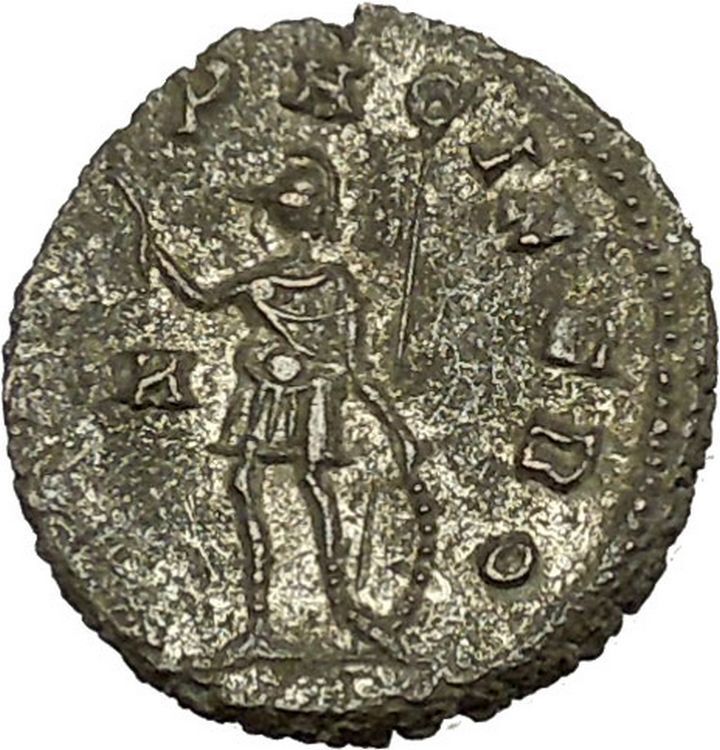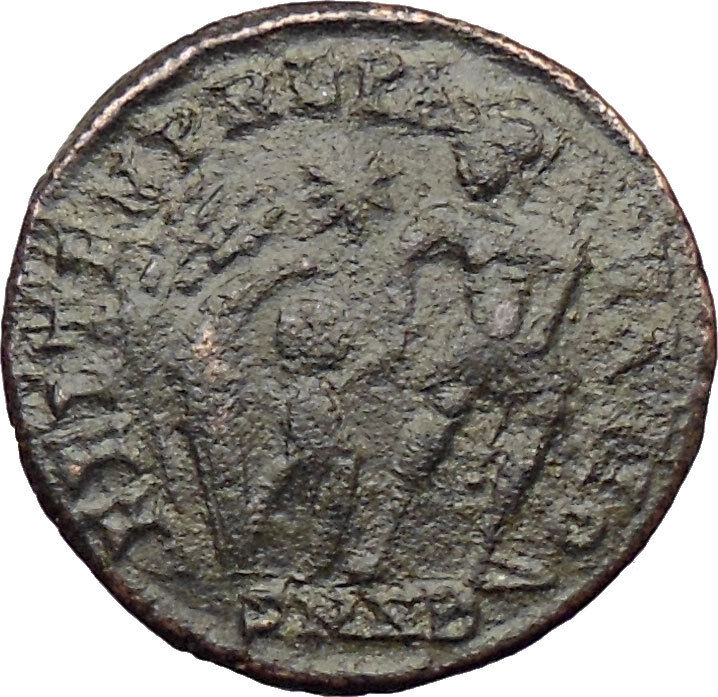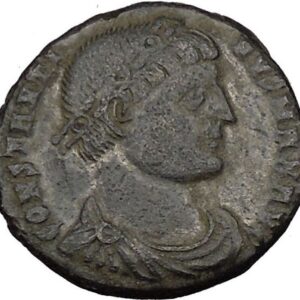|
Claudius II – Roman Emperor: 268-270 A.D.
Bronze Antoninianus 21mm (2.88 grams) Struck at the mint of Rome 268-270
A.D.
Reference: RIC 98c, Normanby 608, Cunetio 1936
IMPCCLAVDIVSAVG – Radiate, draped and cuirassed bust right.
SALVSAVG – Salus standing left, feeding snake on altar and holding scepter.
You are bidding on the exact item pictured,
provided with a Certificate of Authenticity and Lifetime Guarantee of
Authenticity.
Salus (Health) a Goddess of the Romans, the same that was worshipped under
the name of Hygiea by the Greeks, who feigned her to be the daughter of
Asclepius and of Minerva. On a denarius of the Acilia family appears the head
of the goddess and on the reverse a female standing with a serpent in her hand.
The types of this divinity on imperial coins most frequently present to view a
woman clothed in the stola;  sometimes sometimes
she is sitting, at others standing; in others in a recumbent posture, with a
serpent either on her right or her left arm in a quiescent state, rising in
folds or entwined round an altar before her, and receiving food from a patera,
which she holds in her extended hand. It is in this form (which was doubtless
that of her statues and with these symbols) that she is exhibited on most coins
on the imperial series from Galba to Maximianus. She had a celebrated temple at
Rome, painted, it was said, by Q. Fabius, who thence was surnamed Pictor (the
painter) . – There appears to be some affinity between this personification of
Salus, when offering food in a patella to a serpent, and the Lanuvian virgin
represented in the same act on coins bearing the head of Juno Sospita. – The
opinion also has the probability on the face of it, which refers the serpent on
coins, where mention is made of Salus Augusti, or Augustorum, to Aesculapius and
his daughter Hygaeia (or Salus) as deities of Health. – Certain it is that when
those sanitary divinities, and especially when Dea Salus, occur on coins of
Emperors, they indicate that those princes were labouring at the time under some
diseases; on which account, it would seem, sacred rites had been performed for
them and the memorial of the event recorded on public monuments
Marcus Aurelius Claudius (May
10, 213
– January, 270), often referred to as Claudius Gothicus or Claudius II,
was a Roman Emperor
. He ruled the
Roman
Empire
for less than two years (268 – 270), but during that brief time he
managed to obtain some successes. He was later given divine status.
//
Life
Origin
and rise to power
Claudius’ origin is uncertain. He was either from
Sirmium
(Syrmia;
in Pannonia
Inferior) or from Naissus
Dardania
(in
Moesia Superior
); both areas are located in
Serbia
.
Claudius was the commander of the Roman army that decisively defeated the
Goths
at the
Battle of Naissus
in September 268; in the same month, he attained the
throne, amid charges, never proven, that he murdered his predecessor
Gallienus
.
However, he soon proved to be less than bloodthirsty, as he asked the
Roman
Senate
to spare the lives of Gallienus’ family and supporters. He was less
magnanimous toward Rome’s enemies, however, and it was to this that he owed his
popularity.
Claudius, like
Maximinus Thrax
before him, was of barbarian birth. After an interlude of
failed aristocratic Roman emperors since Maximinus’s death, Claudius was the
first in a series of tough soldier-emperors who would eventually restore the
Empire from the
Crisis of the third century
.
Claudius
as emperor
At the time of his accession, the Roman Empire was in serious danger from
several incursions, both within and outside its borders. The most pressing of
these was an invasion of Illyricum and
Pannonia
by
the Goths
. Not
long after being named emperor (or just prior to Gallienus’ death, depending on
the source), he won his greatest victory, and one of the greatest in the history
of Roman arms.

The Roman Empire in 268 A.D
At the
Battle of Naissus
, Claudius and his legions routed a huge Gothic army.
Together with his cavalry commander, the future Emperor
Aurelian
,
the Romans took thousands of prisoners, destroyed the Gothic cavalry as a force
and stormed their laager (a circular alignment of wagons long favored by the
Goths). The victory earned Claudius his surname of “Gothicus” (conqueror of the
Goths), and that is how he is known to this day. More importantly, the Goths
were soon driven back across the
Danube River
, and a century passed before they again posed a serious threat
to the empire.
While this was going on, the Germanic tribe known as the
Alamanni
had crossed the Alps
and attacked the empire. Claudius responded quickly, routing the Alamanni at the
Battle of Lake Benacus
in the late fall of 268, a few months after the
battle of Naissus. He then turned on the
Gallic Empire
, ruled by a pretender for the past fifteen years and
encompassing
Britain
, Gaul
,
and the
Iberian Peninsula
. He won several victories and soon regained control of
Spain and the Rhone river valley of Gaul. This set the stage for the ultimate
destruction of the Gallic Empire under Aurelian.
However, Claudius did not live long enough to fulfill his goal of reuniting
all the lost territories of the empire. Late in 269 he was preparing to go to
war against the Vandals
, who were raiding in
Pannonia
.
However, he fell victim to the
Plague of Cyprian
(possibly
smallpox
),
and died early in January 270. Before his death, he is thought to have named
Aurelian as his successor, although Claudius’ brother
Quintillus
briefly seized power.
The Senate
immediately deified Claudius as “Divus Claudius Gothicus”.
Links
to
Constantinian dynasty
The
Historia Augusta
reports Claudius and Quintillus having another brother
named Crispus and through him a niece. Said niece Claudia reportedly married
Eutropius and was mother to
Constantius Chlorus
. Historians however suspect this account to be a
genealogical
fabrication intended to link
Constantine I
‘s family to that of a well-respected emperor.
|





 sometimes
sometimes



